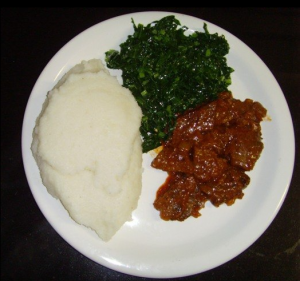Shona
Shona Cuisine
Shona Cuisine
Maize/corn is a staple crop in Zimbabwe, so it features prominently in local cuisine. Peanuts are another crop that does well in Zimbabwe, so peanut-based stews are in plenty. Wild mushroom is another ingredient in the Zimbabwean diet. There also lots of locally grown fruits and vegetables.
Vocabulary associated with food and cooking
- chikafu – food
- kudya – to eat
- kubika – to cook
- kumwa – to drink
- kudya kwemangwanani – breakfast
- kudya kwemasikati – lunch
- kudya kwemanheru – evening meal – supper
- dhinha/ chisvusvuro – dinner
- tudyo – snack (rare)
- muto – soup
- nyama – meat
- nyama yemombe – beef
- hove – fish
- bread – chingwa
- muchero – fruit
- hayanisi – onions
- mupunga – rice
- mbatatisi – potatoes
- mbambaira – sweet potato
- upfu – flour
- mafuta e kubikisa – cooking oil
- mukaka – milk
- nzungu – groundnuts/peanuts
- munyu – salt
- shuga – sugar
- ndiro, mukombe, chipunu, banga – plate, cup, spoon and knife, respectively
- imba yekubikira – kitchen
- ndirikunda chikafu – I want food
- ndinenzara – I am hungry
- ndinoda mupunga nehove – I want rice and fish
- geza maoko – wash your hands
- chikafu chiri kunaka – the food is delicious
- maita basa, ndaguta – thank you, I am full
- ndinenyota – I am thirsty
- ndirikuda mvura – I want water
Food and Drinks
Here are some of the common meals and drinks to expect in a Zimbabwean homestead.
- Sadza – Maizemeal, cooked with maize flour, or sorghum and millet, and water which is normally eaten with collard greens, beef, chicken, or pork stews, and Mopane worms.
- Mutakura/Mangai – mutakura is a mixture of maize, peanuts, bambara nuts and cowpeas. Mangai is a mixture of maize and peanuts)
- Dovi – peanut butter stew
- Madhumbe/Magogoya – yams eaten for breakfast or snack.
- Madora/Mancimbi – Mopane worms – insects that feed on Mopane leaves. They are considered a delicacy in this region.
- Matumbu – beef tripe
- Hohwa/Amakhowa – wild mushrooms
- Mazondo – cow heels
- Bota – porridge
- Hodzeko – sour milk

Sadza
Maizemeal or Sadza is also a staple food in many African communities. In Kenyan and Tanzanian Swahili, it is known as ugali and sembe/sima respectively, sima in Chichewa, ubwali in Bemba, etc.
Some cultural norms associated with food
You eat using the right hand, called rudyi which translates to “the one used for eating” and it is impolite to eat with the left hand even if you are left-handed. Food is communal and traditionally people eat from the same bowl. You do not wipe off your plate. You leave a small amount of food on your plate to indicate you ate to your full.
Scenario: Telling your friend what you ate yesterday for breakfast, lunch, and supper
Shimwari yangu, nezhuro ndakanwa bota mangwanani. Masikati, ndakadya sadza nenyama. Manheru, ndakadya mupunga nematumbu (My friend, yesterday I drank porridge in the morning. Lunch (midday), I ate cornmeal and meat. Supper (evening), I ate rice and tripe).
Grammar notes: Demonstratives
- Ichi ndicho chikafu changu – this is my food.
- Iyi mikombe yangu – these are my cups
- Ndiwo muchero waibva – that is a ripe fruit
- Ndidzo hove dzedu – those are our fish
Demonstratives for the Shona concordial classes (noun classes 1 to 18)
Proximal (this/these) Distal (that/those)
- uyu uyo
- ava avo
- uyu uyo
- iyi iyo
- iri iro
- aya ayo
- ichi icho
- izvi izvo
- iyi iyo
- idzi idzo
- urwu urwo
- aka ako
- utwu utwo
- uhwu uhwo
- uku uko
- apa apo
- uku uko
- umu umo

